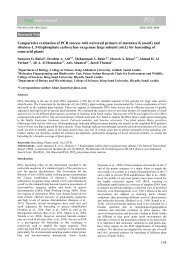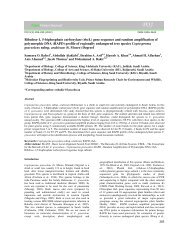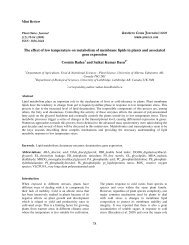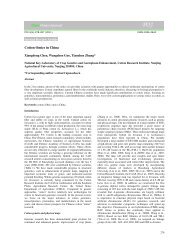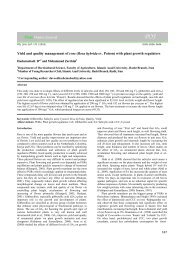Potential of Molecular Markers in Plant Biotechnology - ResearchGate
Potential of Molecular Markers in Plant Biotechnology - ResearchGate
Potential of Molecular Markers in Plant Biotechnology - ResearchGate
Create successful ePaper yourself
Turn your PDF publications into a flip-book with our unique Google optimized e-Paper software.
Review article<br />
Table 2. Summary Advantage and disadvantage <strong>of</strong> Some commonly used markers.<br />
Type <strong>of</strong> markers Advantages Disadvantages<br />
Restriction Fragment<br />
Length Polymorphism<br />
(RFLP)<br />
Randomly Amplified<br />
Polymorphic DNA<br />
(RAPD)<br />
Simple Sequence<br />
Repeat (SSR)<br />
Amplified Fragment<br />
Length Polymorphism<br />
(AFLP)<br />
Sequence-Tagged<br />
Site<br />
(STS)<br />
ISOZYMES<br />
-High genomic abundance<br />
-Co-dom<strong>in</strong>ant markers<br />
-Highly reproducible<br />
-Can use filters many times<br />
-Good genome coverage<br />
-Can be used across species<br />
-No sequence <strong>in</strong>formation<br />
-Can be used <strong>in</strong> plants reliably (well-tested)<br />
-Needed for map based clon<strong>in</strong>g<br />
-High genomic abundance<br />
-Good genome coverage<br />
-No sequence <strong>in</strong>formation<br />
-Ideal for automation<br />
-Less amount <strong>of</strong> DNA (poor DNA acceptable)<br />
-No radioactive label<strong>in</strong>g<br />
-Relatively faster<br />
-High genomic abundance<br />
-Highly reproducible<br />
-Fairly good genome coverage<br />
-High polymorphism<br />
-No radioactive label<strong>in</strong>g<br />
-Easy to automate<br />
-Multiple alleles<br />
-High genomic abundance<br />
-High polymorphism<br />
-No need for sequence <strong>in</strong>formation<br />
-Can be used across species<br />
-Work with smaller RFLP fragments<br />
-Useful <strong>in</strong> prepar<strong>in</strong>g contig maps<br />
-Useful <strong>in</strong> prepar<strong>in</strong>g contig maps<br />
-No radioactive label<strong>in</strong>g<br />
-Fairly good genome coverage<br />
-Highly reproducible<br />
-Can use filters many times<br />
-Useful for evolutionary studies<br />
-Isolation lot easier than that <strong>of</strong> DNA<br />
-Can be used across species<br />
-No radioactive label<strong>in</strong>g<br />
-No need for sequence <strong>in</strong>formation<br />
-Need large amount <strong>of</strong> good quality DNA<br />
-Laborious (compared to RAPD)<br />
-Difficult to automate<br />
-Need radioactive label<strong>in</strong>g<br />
-Clon<strong>in</strong>g and characterization <strong>of</strong><br />
probe are required<br />
-No probe or primer <strong>in</strong>formation<br />
-Dom<strong>in</strong>ant markers<br />
-Not reproducible<br />
-Can not be used across species<br />
-Not very well-tested<br />
-Can not be used across species<br />
-Need sequence <strong>in</strong>formation<br />
-Not well-tested<br />
-Very tricky due to changes <strong>in</strong><br />
patterns with respect to materials<br />
used<br />
-Cannot get consistent map (not<br />
reproducible)<br />
-Need to have very good primers<br />
-Laborious<br />
-Cannot detect mutations out <strong>of</strong> the target<br />
sites<br />
-Need sequence <strong>in</strong>formation<br />
-Clon<strong>in</strong>g and characterization <strong>of</strong><br />
probe are required<br />
-Laborious<br />
-Limited <strong>in</strong> polymorphism<br />
-Expensive (each system is unique)<br />
-Have to know the location <strong>of</strong> the<br />
tissue -Not easily automated<br />
charge and conformation <strong>of</strong> prote<strong>in</strong>s can be detected,<br />
reduc<strong>in</strong>g the resolv<strong>in</strong>g power <strong>of</strong> allozymes.<br />
The other markers generally show <strong>in</strong>termediate<br />
levels <strong>of</strong> polymorphism, result<strong>in</strong>g from base<br />
substitutions, <strong>in</strong>sertions or deletions which may alter<br />
primer anneal<strong>in</strong>g sites and recognition sites <strong>of</strong><br />
restriction enzymes, or change the size <strong>of</strong> restriction<br />
fragments and amplified products. In choos<strong>in</strong>g the<br />
appropriate technique, the level <strong>of</strong> polymorphism<br />
detected by the marker needs to be considered <strong>in</strong><br />
relation to the presumed degree <strong>of</strong> genetic relatedness<br />
with<strong>in</strong> the material to be studied. Higher resolv<strong>in</strong>g<br />
power is required when samples are more closely<br />
related. For example, analyses with<strong>in</strong> species or<br />
among closely related species may call for fast<br />
evolv<strong>in</strong>g markers such as microsatellites. However if<br />
the objective is to study genetic relatedness at higher<br />
taxonomic levels (such as congeneric species),<br />
AFLPs or RFLPs may be a better choice because comigrat<strong>in</strong>g<br />
fast-evolv<strong>in</strong>g markers will have less chance<br />
<strong>of</strong> be<strong>in</strong>g homologous. A primary guid<strong>in</strong>g pr<strong>in</strong>ciple <strong>in</strong><br />
marker selection is that more conservative markers<br />
(those hav<strong>in</strong>g slower evolutionary rates) are needed<br />
with <strong>in</strong>creas<strong>in</strong>g evolutionary distance and vice-versa.<br />
155



